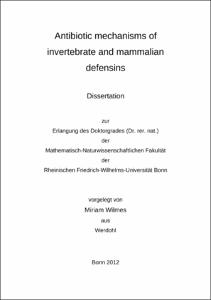Wilmes, Miriam: Antibiotic mechanisms of invertebrate and mammalian defensins. - Bonn, 2013. - Dissertation, Rheinische Friedrich-Wilhelms-Universität Bonn.
Online-Ausgabe in bonndoc: https://nbn-resolving.org/urn:nbn:de:hbz:5n-31207
Online-Ausgabe in bonndoc: https://nbn-resolving.org/urn:nbn:de:hbz:5n-31207
@phdthesis{handle:20.500.11811/5624,
urn: https://nbn-resolving.org/urn:nbn:de:hbz:5n-31207,
author = {{Miriam Wilmes}},
title = {Antibiotic mechanisms of invertebrate and mammalian defensins},
school = {Rheinische Friedrich-Wilhelms-Universität Bonn},
year = 2013,
month = feb,
note = {Multicellular organisms defend themselves against infectious microorganisms by producing a wide array of antimicrobial peptides referred to as host defence peptides (HDPs). These evolutionary ancient peptides are important effector molecules of innate immunity. In addition to their immunomodulatory functions, they display potent direct antimicrobial activity against a broad range of microorganisms, including multiresistant pathogens. Thus, they are considered as promising candidates for the development of novel anti-infective agents.
Almost all HDPs are cationic and amphipathic. Hence, it has been generally assumed that these peptides interact unspecifically with negatively charged microbial membranes and subsequently disrupt membrane barrier functions. However, evidence is increasing that the antibiotic activity of HDPs can be much more targeted as it was originally proposed.
One important HDP class comprises defensins which are characterised by disulphide-stabilised β-sheets as the major structural component. In this work, the mode of action of defensins from diverse origins was investigated to gain further insights into the molecular mechanisms of defensin-mediated killing.},
url = {https://hdl.handle.net/20.500.11811/5624}
}
urn: https://nbn-resolving.org/urn:nbn:de:hbz:5n-31207,
author = {{Miriam Wilmes}},
title = {Antibiotic mechanisms of invertebrate and mammalian defensins},
school = {Rheinische Friedrich-Wilhelms-Universität Bonn},
year = 2013,
month = feb,
note = {Multicellular organisms defend themselves against infectious microorganisms by producing a wide array of antimicrobial peptides referred to as host defence peptides (HDPs). These evolutionary ancient peptides are important effector molecules of innate immunity. In addition to their immunomodulatory functions, they display potent direct antimicrobial activity against a broad range of microorganisms, including multiresistant pathogens. Thus, they are considered as promising candidates for the development of novel anti-infective agents.
Almost all HDPs are cationic and amphipathic. Hence, it has been generally assumed that these peptides interact unspecifically with negatively charged microbial membranes and subsequently disrupt membrane barrier functions. However, evidence is increasing that the antibiotic activity of HDPs can be much more targeted as it was originally proposed.
One important HDP class comprises defensins which are characterised by disulphide-stabilised β-sheets as the major structural component. In this work, the mode of action of defensins from diverse origins was investigated to gain further insights into the molecular mechanisms of defensin-mediated killing.},
url = {https://hdl.handle.net/20.500.11811/5624}
}






